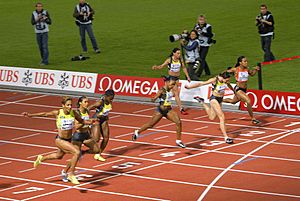Sprint facts for kids
Sprints are super exciting, short running races in sports like track and field. Unlike long-distance races where runners save energy, sprinters run as fast as they possibly can from start to finish! These races are often some of the most popular events at the Olympic Games because they are so quick and thrilling.

Contents
What are the Main Sprint Distances?
The most common sprint distances you'll see are 60 meters, 100 meters, 200 meters, and 400 meters. Each distance tests a runner's speed and power in a slightly different way.
The 60-Meter Sprint
The 60-meter sprint is the shortest common sprint race. It is usually run indoors on an indoor track. This race is all about explosive power right from the start. Runners have to reach their top speed very quickly. It's often used to help sprinters practice their starting technique.
The 100-Meter Sprint
The 100-meter sprint is often called the "dash" and is one of the most famous events in track and field. It is seen as the ultimate test of pure speed. The world's fastest runners compete in this event. The race is over in less than 10 seconds for top athletes!
The 200-Meter Sprint
The 200-meter sprint is a bit longer than the 100-meter race. Runners start on a curve of the track and then straighten out for the final part. This race requires a mix of speed and the ability to hold that speed for a longer time. It tests both a runner's initial burst and their speed endurance.
The 400-Meter Sprint
The 400-meter sprint is a full lap around a standard outdoor track. It is sometimes called a "long sprint" because it requires both speed and a lot of stamina. Runners need to manage their energy carefully to maintain a fast pace for the entire distance. It's a very challenging race that pushes athletes to their limits.
How are Sprint Races Run?
Sprint races have specific rules and techniques that runners follow.
Starting the Race
Sprinters start their races from special devices called starting blocks. These blocks help runners push off powerfully at the sound of the starting gun. Athletes get into a crouched position in the blocks. They wait for the "On your marks," "Set," and then the sound of the gun. A false start happens if a runner moves before the gun.
Staying in Your Lane
In most sprint races (like the 100m, 200m, and 400m), each runner must stay in their own marked lane on the track. If a runner steps out of their lane, especially if it gives them an advantage, they can be disqualified from the race. This ensures fairness for all competitors.
Crossing the Finish Line
The race ends when a runner's torso (their body, not just their head, arms, or legs) crosses the finish line. Races are timed very precisely, often down to a thousandth of a second, using electronic sensors and cameras.
Famous Sprinters in History
Many incredible athletes have become famous for their speed in sprint races.
One of the most well-known sprinters is Usain Bolt from Jamaica. He is considered the fastest man in history. He won many gold medals at the Olympic Games and set world records in the 100-meter and 200-meter sprints. His amazing speed and friendly personality made him a global superstar.
Other legendary sprinters include Jesse Owens from the United States, who won four gold medals at the 1936 Berlin Olympics, and Florence Griffith-Joyner, also from the U.S., who set incredible world records in women's sprints in the late 1980s. These athletes showed the world what incredible speed and dedication can achieve.
Training for Sprinting
Becoming a great sprinter takes a lot of hard work and training. Athletes focus on building strength, power, and speed.
They do exercises to make their legs and core muscles strong. They also practice their starting technique over and over again. Sprinters often do short, intense bursts of running, followed by rest, to improve their explosive power. They also work on their running form to be as efficient and fast as possible.
Sprints in the Olympic Games
Sprints are a highlight of the Olympic Games, which happen every four years. Athletes from all over the world compete for gold, silver, and bronze medals. The sprint finals are often some of the most watched events, as everyone wants to see who will be crowned the fastest in the world. The excitement of these races is truly amazing!
Related pages

